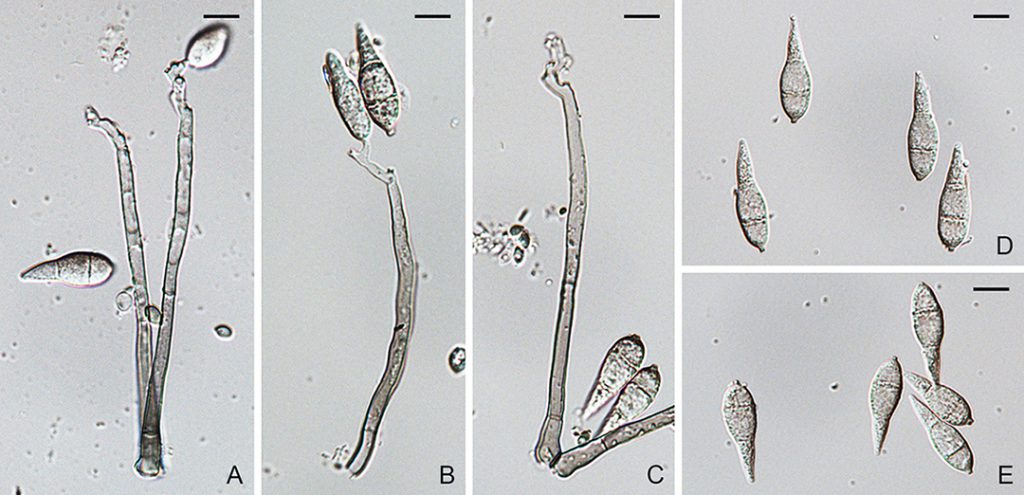
Figure. Pyricularia oryzae (181001p). A–E. Conidiophores and conidia. Scale bars: A–E = 10µm.
Pyricularia oryzae Cavara, Fung. Long. Exsicc. 1: no. 49 (1892).
MycoBank: MB224486.
≡ Dactylaria oryzae (Cavara) Sawada, Spec. Bull. Agric. Exp. Station Formosa 16: 59 (1917).
= Magnaporthe oryzae B.C. Couch, Mycologia 94:692 (2002).
= Pyricularia graminis-tritici Castroag., S.I. Moreira, Maciel, B.A. McDonald, Crous & Ceresini, Persoonia 37: 211 (2016).
Ascomata perithecial, superficial or submerged, solitary or gregarious, dark brown to black, 60–300 µm diam, with a cylindrical, hyaline to brownish neck, 60–150 × 100–1200 µm. Paraphyses hyaline, septate, dissolving at maturity. Asci 8-spored, unitunicate, clavate, 7–10 × 55–90 µm, with a refractive ring. Ascospores 1–3-seriate, fusiform, straight or slightly curved, 3-septate, not or slightly constricted at septum, hyaline, smooth, 4–7 × 17–24 µm (Sexual state description from (Couch and Kohn, 2002; Yaegashi and Udagawa, 1978). Conidiophores solitary, erect, straight or curved, unbranched, 1–3-septate, brown, smooth, 85–140 × 3–6.5 µm. Conidiogenous cells integrated, terminal or intercalary, pale brown, smooth, 65–100 × 3–6 µm, with several protruding denticles, 0.5–1.5 × 1–2 µm. Conidia solitary, pyriform to obclavate, 2-septate, light brown, smooth to finely roughened, 25–33.5 × 7–11 µm, with a truncate hilum, 0.5–1.5 × 1–2 µm.
Typification: Lectotype of Pyricularia oryzae Cavara, Fungi Longobardiae no. 49 (Rossman et al., 1990). Holotype of “Magnaporthe oryzae” BPI841383 (Couch and Kohn, 2002). Isotype of “M. oryzae” TRTC52742 (Couch and Kohn, 2002).
Genome sequences: AACU00000000 (Genome).
Specimens examined: Guyana and other localities, cross of strains from Oryza sativa and Eleusine, 2002, B.C. Couch, Guy 11 and 2539 (BPI841383). USA, New Jersey, New Brunswick, on Festuca brevipila, 1 Oct. 2018, P.L. Vines, RUTPP181001p4; RUTPP181001p48; RUTPPd300452; RUTPPd300453; ibid., Adelphia, on Festuca arundinacea, 17 Oct. 2018, P.L. Vines, RUTPP181017p1; RUTPP181017p2.
Hosts/substrates: On Eleusine coracana, Festuca arundinacea, F. brevipila, Hordeum vulgare, Lolium perenne, Oryza sativa, Setaria italica, and Triticum (Poaceae).
Distribution: Worldwide.
Notes: Rice blast caused by Pyricularia oryzae is one of the most devastating diseases of Oryza sativa (rice) worldwide. Pyricularia oryzae can also cause blast diseases on Triticum (wheat), which emerged in Brazil in 1985 and has spread to Argentina, Bolivia, and Paraguay as well as Bangladesh by 2016 (Callaway, 2016). It can infect and damage other crops including Eleusine coracana (finger millet) and Setaria italica (foxtail millet). In addition, Pyricularia oryzae was proven to be causal agent of the grey leaf spots on turfgrasses, Lolium perenne (perennial ryegrass) and Festuca arundinacea (tall fescue), and a recent study has confirmed its pathogenicity on Festuca brevipila (hard fescue) (Vines et al., 2021).
Copyright 2022 by The American Phytopathological Society. Reproduced, by permission, from Luo, J., and Zhang, N. 2022. The Rice Blast Fungus and Allied Species: A Monograph of the Fungal Order Magnaporthales (https://my.apsnet.org/APSStore/Product-Detail.aspx?WebsiteKey=2661527A-8D44-496C-A730-8CFEB6239BE7&iProductCode=46826). American Phytopathological Society, St. Paul, MN.